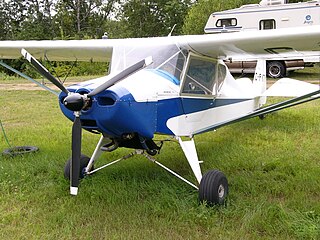
The Bowers Fly Baby is a homebuilt, single-seat, open-cockpit, wood and fabric low-wing monoplane that was designed by famed United States aircraft designer and Boeing historian, Peter M. Bowers.

The Evans VP-2 is a development of the Evans VP-1 Volksplane, both of which were designed in La Jolla, California by aeronautical engineer William Samuel "Bud" Evans. Evans had formerly worked at Convair, Ryan Aircraft and General Dynamics.

The Cassutt Special is a single-seat sport and racing aircraft designed in the United States in 1951 for Formula One air races. Designed by ex-TWA captain Tom Cassutt, it is a mid-wing cantilever monoplane with fixed tailwheel undercarriage. The fuselage and tail are of fabric-covered steel tube construction, and the wings are built from plywood over wooden ribs. An updated taper-wing design was first flown in 1971 on Jim Wilson's "Plum Crazy".

The Sonerai is a small, VW-powered homebuilt aircraft, designed by John Monnett. The Sonerai began to compete as a single-seat, mid-wing, tailwheel Formula-V racer class formed in 1972. The Sonerai soon evolved into a two-seat model called the Sonerai II.

The Druine D.31 Turbulent is a French single-seat ultralight Homebuilt aircraft designed by Roger Druine.
The Pazmany PL-4A is a single-seat, single-engine sport aircraft developed in the United States and first flown in 1972. It is marketed for homebuilding from plans, and 686 sets had sold by 1985. The PL-4A is a conventional, low-wing cantilever monoplane with an enclosed cabin and fixed, tailwheel undercarriage. The design features a T-tail, chosen to facilitate folding the wings. Construction throughout is of metal, using standard extruded sections for the longerons and pop rivets as the basic fastener. The standard powerplant is a Volkswagen air-cooled engine of 60 hp (45 kW) Construction time is estimated to be around 1,000–1,500 hours.
The Pazmany PL-9 Stork is an American single-engined high-wing monoplane designed by Ladislao Pazmany as a ¾ scale variant of the Second World War Fieseler Storch for the home builder market.

The Fisher Celebrity is a Canadian two-seat, conventional landing gear, single engined, biplane kit aircraft designed for construction by amateur builders. Fisher Flying Products was originally based in Edgeley, North Dakota, United States but the company is now located in Dorchester, Ontario, Canada.
The Fisher Youngster is a Canadian single-seat, conventional landing gear, single-engined, biplane kit aircraft designed for construction by amateur builders. The aircraft was inspired by the German Bücker Bü 133 Jungmeister aerobatic aircraft of the 1930s.

The Fisher Dakota Hawk is a Canadian side-by-side two-seat, conventional landing gear, single-engined, high-wing monoplane kit aircraft designed for construction by amateur builders.

The Norman Aviation Nordic VI is a Canadian fixed wing ultralight aircraft designed by Jacques Norman.

The Smith DSA-1 Miniplane is a single-seat, single-engine sport aircraft designed in the United States in the 1950s and marketed for home building.
The Loehle Sport Parasol is an American single-seat, parasol winged, single engine, ultralight aircraft produced in kit form by Loehle Aircraft for amateur construction. The aircraft meets the requirements of the US FAR 103 Ultralight Vehicles regulations.

The Flying K Sky Raider is a family of American, high wing, strut-braced, single engine, conventional landing gear ultralight aircraft that was designed by Ken Schrader and produced by Flying K Enterprises and later Sky Raider LLC of Caldwell, Idaho for amateur construction.

The ATEC 122 Zephyr 2000 is a Czech ultralight aircraft, designed by Oldrich Olansky and produced by ATEC v.o.s. of Libice nad Cidlinou. The aircraft is supplied as a complete ready-to-fly-aircraft or as a kit for amateur construction.
The AV Leichtflugzeuge Vagabund is a German ultralight aircraft that was designed by Birk Meier, Hans Grannemann and Robert Kaps and produced by AV Leichtflugzeuge of Haren, Germany. The aircraft is supplied as a kit or plans for amateur construction or as a complete ready-to-fly-aircraft.
The Ehroflug Coach II S is a Swiss ultralight aircraft, designed by Egon Scheibe and produced by Ehroflug of Altnau. It was introduced in 1989. The aircraft is supplied as plans, as a kit for amateur construction or as a complete ready-to-fly-aircraft.

The Fly Synthesis Storch is an Italian ultralight aircraft, designed and produced by Fly Synthesis, introduced in 1990. The aircraft is supplied as a complete ready-to-fly-aircraft or as a kit for amateur construction.

The Microleve Corsario is a Brazilian amphibious ultralight flying boat that was designed and produced by Microleve of Rio de Janeiro. The aircraft was supplied as a kit for amateur construction.

The Flitzer Z-21 or Staaken Flitzer is a British amateur-built aircraft, designed by Lynn Williams and produced by Flitzer Sportplanes of Aberdare, Wales. The aircraft is supplied as plans for amateur construction.

















